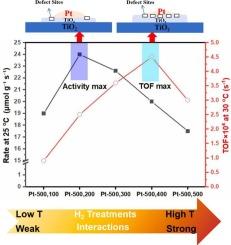Harnessing metal-support interaction on Pt/TiO2 catalysts for oxygen vacancy engineering via H2 reduction toward low-temperature ethylene oxidation
IF 6.5
1区 化学
Q2 CHEMISTRY, PHYSICAL
引用次数: 0
Abstract
The Mars-van Krevelen (MvK) mechanism is widely recognized for enabling ethylene oxidation over Pt-oxide catalysts, which plays a key role in fruit and vegetable preservation. However, whether interfacial engineering can effectively promote low-temperature ethylene removal remains unclear. Herein, we systematically tuned the metal-support interaction in 2 % Pt/TiO2 catalysts via hydrogen reduction at different temperatures to construct a series of catalysts with distinct structural and electronic properties. Structural characterizations including HR-TEM and CO chemisorption revealed that increased reduction temperature led to progressive TiO2 encapsulation of Pt nanoparticles, decreasing Pt dispersion and altering the surface geometry. Meanwhile, XPS and H2-TPR analyses confirmed the generation of Ti3+ species and surface oxygen vacancies, both of which increased with reduction temperature. Kinetic studies revealed a bifunctional mechanism in which metallic Pt served as the primary site for ethylene activation, while oxygen vacancies facilitated O2 dissociation and functioned as the rate-determining step. Catalytic evaluation demonstrated that an optimal balance between Pt dispersion and oxygen vacancy concentration enabled stable and efficient ethylene conversion under ambient conditions. This study provides a mechanistic basis to manipulate metal-support interactions and engineer bifunctional active sites, offering valuable guidance for the rational design of low-temperature oxidation catalysts in practical ethylene removal applications.

利用Pt/TiO2催化剂上的金属-载体相互作用进行氢还原低温乙烯氧化氧空位工程
Mars-van Krevelen (MvK)机制被广泛认为可以使pt -氧化物催化剂上的乙烯氧化,这在水果和蔬菜保存中起着关键作用。然而,界面工程是否能有效促进低温乙烯脱除尚不清楚。本文通过在不同温度下的氢还原,系统地调整了2 % Pt/TiO2催化剂中的金属-载体相互作用,构建了一系列具有不同结构和电子性能的催化剂。包括HR-TEM和CO化学吸附在内的结构表征表明,还原温度的升高导致TiO2逐渐包裹Pt纳米粒子,降低Pt的分散性并改变表面几何形状。同时,XPS和H2-TPR分析证实了Ti3+的生成和表面氧空位的增加,两者都随着还原温度的升高而增加。动力学研究揭示了一个双功能机制,其中金属Pt作为乙烯活化的主要位点,而氧空位促进O2解离并作为速率决定步骤。催化评价表明,Pt分散和氧空位浓度之间的最佳平衡可以在环境条件下实现稳定高效的乙烯转化。该研究为操纵金属-载体相互作用和设计双功能活性位点提供了机制基础,为实际乙烯脱除中低温氧化催化剂的合理设计提供了有价值的指导。
本文章由计算机程序翻译,如有差异,请以英文原文为准。
求助全文
约1分钟内获得全文
求助全文
来源期刊

Journal of Catalysis
工程技术-工程:化工
CiteScore
12.30
自引率
5.50%
发文量
447
审稿时长
31 days
期刊介绍:
The Journal of Catalysis publishes scholarly articles on both heterogeneous and homogeneous catalysis, covering a wide range of chemical transformations. These include various types of catalysis, such as those mediated by photons, plasmons, and electrons. The focus of the studies is to understand the relationship between catalytic function and the underlying chemical properties of surfaces and metal complexes.
The articles in the journal offer innovative concepts and explore the synthesis and kinetics of inorganic solids and homogeneous complexes. Furthermore, they discuss spectroscopic techniques for characterizing catalysts, investigate the interaction of probes and reacting species with catalysts, and employ theoretical methods.
The research presented in the journal should have direct relevance to the field of catalytic processes, addressing either fundamental aspects or applications of catalysis.
 求助内容:
求助内容: 应助结果提醒方式:
应助结果提醒方式:


